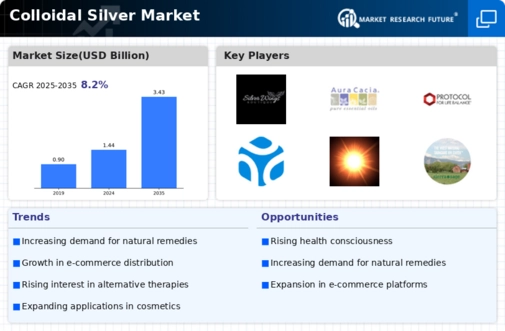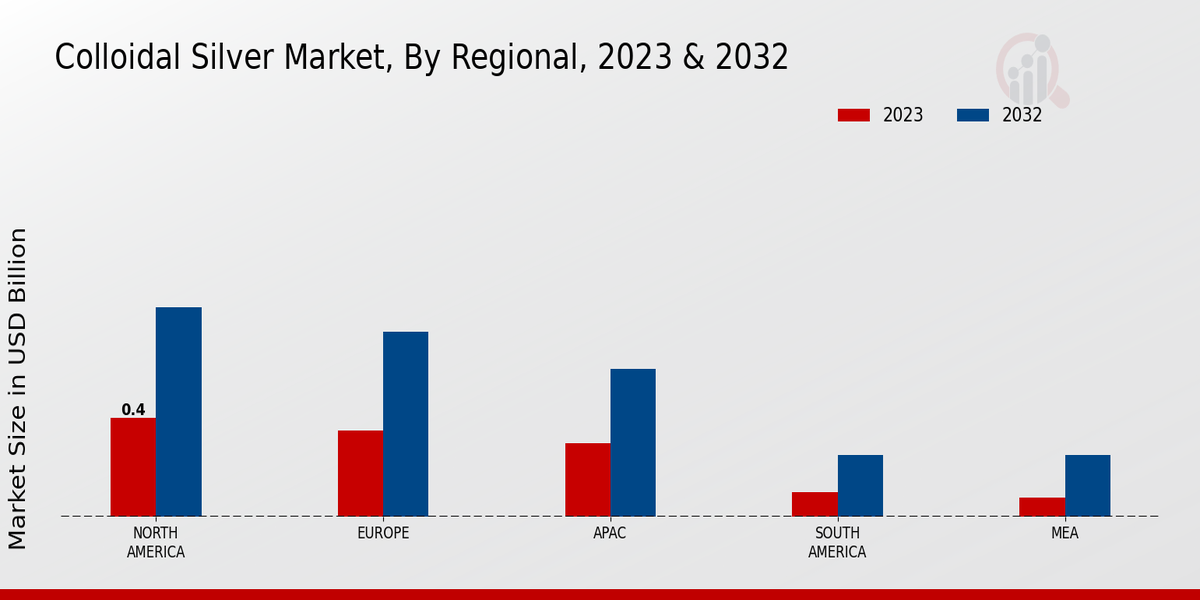Market Growth Projections
The Global Colloidal Silver Market Industry is projected to experience substantial growth over the next decade. With an estimated market value of 1.44 USD Billion in 2024, it is expected to reach 3.43 USD Billion by 2035, reflecting a compound annual growth rate (CAGR) of 8.21% from 2025 to 2035. This growth trajectory indicates a robust demand for colloidal silver across various sectors, including healthcare, cosmetics, and agriculture. The increasing recognition of its antimicrobial properties and versatility as a natural remedy positions colloidal silver favorably within the global market landscape.
Expansion of the Cosmetic Industry
The Global Colloidal Silver Market Industry benefits from the expansion of the cosmetic sector, where colloidal silver is increasingly incorporated into skincare products. Consumers are drawn to its purported antibacterial and anti-inflammatory properties, which are believed to enhance skin health. As the global skincare market continues to grow, the demand for innovative ingredients like colloidal silver is likely to rise. This trend is supported by the projected market growth, with estimates indicating a rise to 3.43 USD Billion by 2035. The integration of colloidal silver in cosmetics not only caters to consumer preferences for natural ingredients but also aligns with the industry's shift towards more effective formulations.
Increasing Applications in Agriculture
The Global Colloidal Silver Market Industry is witnessing a surge in applications within the agricultural sector. Farmers are increasingly utilizing colloidal silver as a natural pesticide and fungicide, capitalizing on its antimicrobial properties to enhance crop yield and quality. This trend is particularly relevant as the global population continues to grow, necessitating more efficient agricultural practices. The adoption of colloidal silver in agriculture aligns with sustainable farming initiatives, potentially leading to a more environmentally friendly approach to pest management. As awareness of these benefits spreads, the market for colloidal silver in agriculture is expected to expand, contributing to overall industry growth.
Consumer Preference for Natural Remedies
The Global Colloidal Silver Market Industry is significantly influenced by the growing consumer preference for natural remedies over synthetic alternatives. As individuals become more health-conscious, there is a marked shift towards products perceived as safe and effective. Colloidal silver, often marketed as a natural antimicrobial agent, aligns with this trend, appealing to consumers seeking holistic health solutions. This shift is likely to drive market growth, particularly as awareness of colloidal silver's benefits continues to spread. The industry's ability to adapt to these changing consumer preferences will be crucial in maintaining its competitive edge in the global market.
Rising Demand for Antimicrobial Products
The increasing global awareness regarding health and hygiene drives the demand for antimicrobial products, including colloidal silver. As consumers seek effective solutions for infection control, the Global Colloidal Silver Market Industry is experiencing significant growth. In 2024, the market is projected to reach 1.44 USD Billion, reflecting a heightened interest in natural antimicrobial agents. This trend is particularly evident in the healthcare sector, where colloidal silver is utilized in wound dressings and medical devices. The potential of colloidal silver to combat antibiotic-resistant bacteria further enhances its appeal, suggesting a robust future for this market.
Technological Advancements in Production
Technological advancements in the production of colloidal silver are poised to enhance the efficiency and quality of the Global Colloidal Silver Market Industry. Innovations in manufacturing processes, such as improved methods for particle size control and stabilization, are likely to result in higher-quality products. These advancements not only improve the efficacy of colloidal silver but also reduce production costs, making it more accessible to a broader range of consumers. As the industry evolves, the integration of cutting-edge technologies could stimulate market growth, fostering a competitive landscape that encourages further innovation and development.












